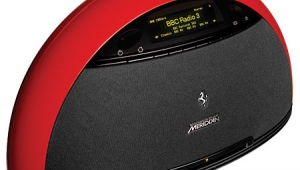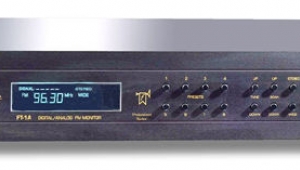| Columns Retired Columns & Blogs |
Marantz ST551 FM tuner

The Marantz ST-74 tuner, reviewed in Vol.8 No.7, was described as having "butter-and-marmalade appearance and AM performance, but dry-toast FM." The latest offering from Marantz, the ST551 (footnote 1), has not quite as sweet AM or appearance, but its more palatable FM makes it one of the best-sounding tuners encountered. It doesn't lack features either—remote control of manual tuning, scan, band selection, and presets—all at a fairly low price.
Footnote 1: The actual model reviewed was the slightly cosmetically different but otherwise identical ST560, which is not available in the USA.
A functional layout is used on the front panel. From left to right are the power switch, band selectors, combined mute-mono/stereo switch, four-digit off-white-against-aqua frequency display, infrared remote-control sensor, controls for eight AM and 16 FM presets, and a large, easy-to-use tuning rocker switch. Overall, the tuner looks businesslike and is highlighted with dull gold lettering. The rear panel contains terminals for AM and 75- or 300-ohm FM antennas, RCA audio jacks, a switched 500W accessory outlet, and provision for marriage to a complete remote-control Marantz system.
Circuit Design
As is often the case with audio components, simple circuits yield the best results. The ST551 was designed to work reasonably well with a minimum parts count.
The tuner contains an unusually well-filtered and regulated power supply to support the remote-control circuitry. Also included are an active low-pass filter from the PLL synthesizer to the FM local oscillator, and an effective buffer amplifier to isolate the local oscillator from the PLL controller. The above three factors contribute to the excellent low-noise audio heard from this tuner.
Specifications
Above-average specifications tell the story of why this tuner has the sonic finesse of a fine tuner. Capture ratio is 0.9dB, meaning the tuner can effectively mask a weaker station on the same frequency. S/N ratio in stereo is claimed as 70dB. It was actually an outstanding 83dB, about as quiet as the McIntosh MR 80 and the Luxman T-02. Stereo separation is stated as 45dB. It proved to be 53dB—as good as I have ever measured. Subcarrier and SCA rejection were barely adequate at 40-45dB. However, little high-frequency grundge or SCA birdies were heard. Sensitivity and selectivity ratings are typical, and were not exceeded.
FM Audio Quality
The ST551 was compared with an unusual number of tuners (those in italics were courtesy of the Connecticut Audio Society): Onkyo T-9090, Kenwood KT-8300, Sansui TU-9900, Magnum Dynalab FT-101, Pioneer F-77, Sequerra Model 1, Yamaha T-85 and T-70, and the tuner section of a McIntosh MAC4200 receiver. Also used as a secondary reference were tapes made from Onkyo T-4087, Bogen TP-100, and Luxman T-02 tuners. In no case was the ST551 outclassed in projecting a full-bodied soundstage with accompanying low intermodulation distortion. With the exception of the Mac, all tuners in the first group sounded restricted and choked in the critical midrange voice area when directly compared with the ST551. However, the MAC4200 had an extra 2dB under 500Hz when listened to via the record outputs. (I hope to test this same tuner section in the separate MR7082 to make a more proper judgment.)
Although not available for direct-air comparison, I'm sure the Quad FM4, NEC T-6E, Bogen TP-100, Mission Cyrus, and the Arcam Alpha would have strutted equal sonic virtues. What I can conclude is that, when fed a clean moderate or strong signal, the ST551 produces audio equal to the best. A word of caution here: if a tuner won't receive a station at all, its sonic worth is limited. For instance, the Yamaha T-85, Onkyo T-9090, and McIntosh MR 80 will receive stations clearly in stereo that can be heard, at best, as hopeless splatter on a wide-band tuner such as the ST551. In actual use, therefore, it is very rare for a less selective tuner to produce the best audio, due to the crowded RF environment in the US. And I'll be damned if it isn't always the hardest stations to get that have the best programming. (This must be an FCC regulation closely adhered to.)
AM Section
As received, the FM alignment on this tuner was on the money, but the AM was not. After alignment, the loop sensitivity was a typical 300µV/m. But, believe it or not, the high-frequency response extended to nearly 7kHz, with unusually low distortion. Music actually sounded like music on the ST551.
Conclusion
One of the curious things noticed was how good this tuner sounds with my 24-year-old Marantz Model 5 amps. Slowly this gap of excellence is being filled. For instance, the 1986 Marantz PM-74 amplifier, though not widely marketed in the US, and the CD-74 CD player, are serious audio components. (The amp was found by Sam Tellig to be a winner when using the line inputs.) And the 1987 June CES saw the introduction of products that will ensure the pioneer Marantz label will not go entirely the route of the rack-system bandwagon.
The ST551 will not go down in history as one of the greats, as did the Marantz 10B, but it receives my recommendation in order to appreciate what can be heard from properly engineered stations. With a good antenna and no strong signals on adjacent channels, the ST551 will perform well.
Footnote 1: The actual model reviewed was the slightly cosmetically different but otherwise identical ST560, which is not available in the USA.
- Log in or register to post comments






















